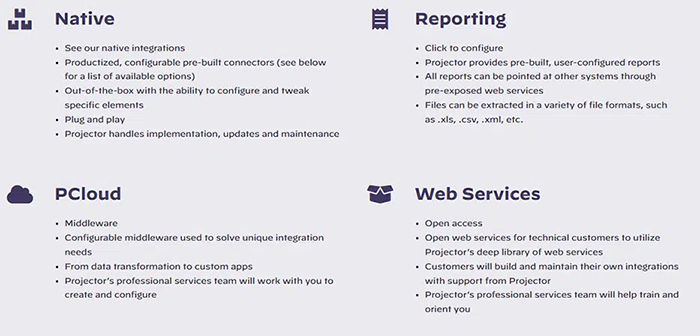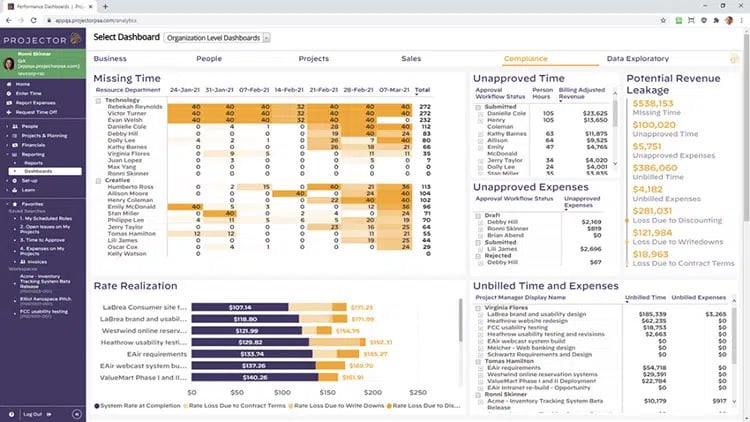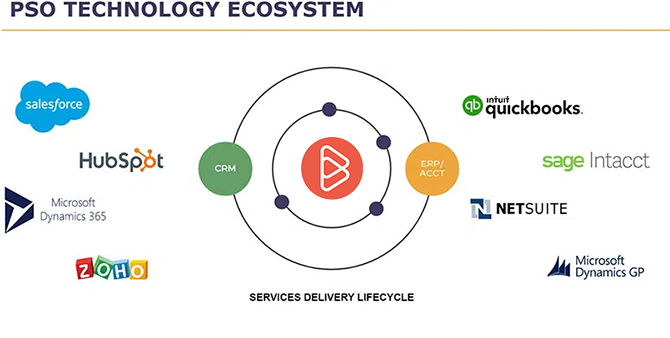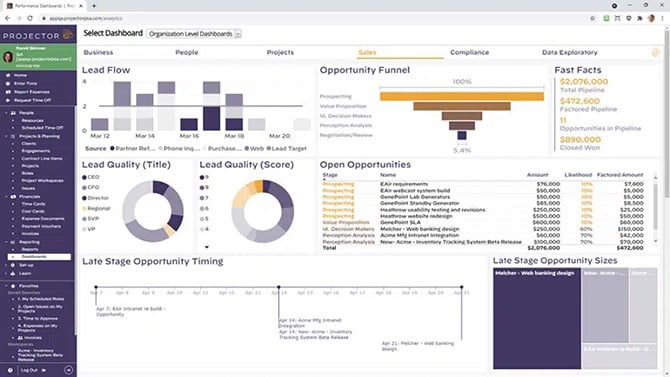
Finding the Right Integration Strategy for Professional Services Success
Today, your LinkedIn feed is likely riddled with companies looking to offer Integration Platforms as a Service (IpaaS) solutions to meet your integration strategy needs for your professional services organization. Often, there are claims about integrations that can be stood up in hours with no code or technical experience required that will change your business and double or even triple your revenue.
What is often not mentioned is the effort required of you and your team, the viability of the integration and/or the positive impact it may have (or not have) on your business.
Most of us who have been in technology for some time realize that integration is complex, difficult, and is most valuable when driven by use cases. Experience has shown us that the effective use of precious resources should be driven by a technology integration strategy that supports a professional services organization’s business objectives. Keep reading to understand what to consider to help guide you when integrating into other applications within your unique technology ecosystem to optimize your application stack now and in the future.
A Smart Data Integration Strategy Starts With: What Problem Are You Looking to Solve?
We regularly hear from clients on the operations and technology side of the business that they need “real-time” integration, APIs, or streaming data. While there is often a real need for all three of these implementations in certain scenarios, we tend to focus instead on, “What problem are you looking to solve?” Starting with a solution-focused data integration strategy allows you to think broadly about the options you have for an efficient solution.
For example, we hear from nearly every client with a CRM that two-way streaming data is a “must have.” However, when we break down not only the methods by which we can support an integrated solution, but also the level of effort required on both sides to arrive there and maintain the solution, we often find a simple approach is more desirable.
In the case of CRM integrations, the most common need is to simply have pipeline and contracts flow into a professional services automation (PSA) solution for visibility and project forecasting, a solution that is less complex to maintain and achieves the goal faster. So, we encourage you to start by really understanding your business objectives and what you’re trying to achieve. Other questions to consider include:
- Are you willing to invest in developing and maintaining integrations between applications, or do you prefer a more hands-off approach?
- Do you want custom integrations that suit your unique business requirements, or do you prefer out-of-the-box solutions that are ready to deploy?
- How will connecting your system data allow you to scale your software stack (or not) as you grow?
Once you’ve defined your integration needs, it’s time to choose an appropriate system integration method.
System Integration Methods for Professional Services
Some system integration methods and approaches require more work than others, and some are tied to a tech ecosystem or are platform agnostic. When thinking about the right system integration method for your services firm, it’s important that the method chosen is aligned with the resources and capabilities available within your organization. It’s also key to understand how much time and money you’re willing to put into connecting your data reliably and efficiently.
Projector by BigTime’s four system integration methods for professional services include:
- Native Integration Strategy. A native integration is one that is part of the core software and is developed by the same company that created the software. Native integrations are typically the easiest and quickest to implement out-of-the-box with the ability to configure and tweak specific elements. These integrations are a plug-and-play type with productized and configurable pre-built connectors for efficient syncing.
- Reporting Integration Strategy. Reporting is a click-to-configure integration type for professional services. Professional services organizations can access pre-built, user-configured reports. The reports can be pointed to other systems already being used by the company through pre-exposed web services, and files can be extracted in a variety of file formats including .xls, .csv, .xml, and more.
- PCloud Integration Strategy. A PCloud integration type is configurable middleware used to solve a service firm’s unique integration needs. Ranging from data transformation to custom apps, this type involves a service organization working with a software company to create and configure an integration.
- Web Services Integration Strategy. Web services provides the ability for open access integrations, allowing technical customers to utilize a deep range of possibilities. In this instance, professional services organizations typically build and maintain their own integrations with support from a software company like BigTime.

Four system integration methods for professional services.
Why an Integration Strategy is Important for Professional Services Organizations
Professional services organizations manage a great deal of data, especially larger organizations where the volume of data significantly grows. When developing your integration strategy, be certain to consider departmental priorities as well as overall outcomes that drive company success. Use a mix of the integration methods outlined above when considering each system to integrate with your PSA.
CRM systems are invested in evasive data and integration methods to preserve their own product offerings, which is fine for Sales teams around which the software was developed. But while pipelines and deals are managed continuously in real time in the CRM, time and resources data associated with those deals may only need to be managed with a daily pull into PSA software like BigTime. Pipeline contracts flow into new projects in Projector by BigTime, for instance, aligning roles and resources with skill-based matching to address any potential staffing shortfalls. This keeps the “noise” of continual CRM updates to a minimum.
On the other hand, project delivery, invoicing, and accounting are regularly so intertwined that having disparate systems can be a real challenge to operations teams. Closing out end of the month or quarterly operations and financials can be an exercise in constant vigilance. Without a data integration strategy that keeps information flowing in real-time, the burden of keeping track of project status, outstanding hours and expenses, revenue leakage, and a host of other follow ups falls to Operations—resulting in them becoming de facto project managers in their own right.

A data integration strategy keeps information flowing in real time to streamline operations.
At the same time, project managers and resources must juggle continuous delivery for their clients while routinely providing status updates and answering questions to keep the rest of the business informed about where the numbers will land. In this scenario, there are many PSA software integrations running with many common accounting systems like Quickbooks, NetSuite, Microsoft Business Central, Sage Intacct, and more.
 Examples of a technology ecosystem at a professional services organization.
Examples of a technology ecosystem at a professional services organization.
An integrated application stack paves the way for operations and finance to quickly and easily get a pulse on project status, revenue leakage, and rate realization, reducing the number of calls and emails to PMs and resources who should be focused on delivery. And invoicing and revenue recognition are key features of a PSA solution like BigTime that can work seamlessly with your accounting system to keep payments on time and projects on budget.
PSA Software Integration Strategy Examples
Outside of the typical use cases and out of the box integrations, professional services organizations and the market often need a more customized approach to problem solving.
One of our larger clients had thousands of resources all over the world submitting their timesheets through a homegrown, custom developed solution when they selected Projector by BigTime as their PSA. Moving this volume of employees to a new time entry system would be a huge project in and of itself. The client needed a problem-based approach to ensuring there was virtually no lag between their existing timesheets and implementing Projector by BigTime as their PSA system. A custom solution allowed continuity of business while the time migration project was completed.
We come up against this type of challenge regularly, which is why we continue to build BigTime Software to be flexible and platform agnostic. In this and many similar situations, we have built custom cloud-based apps to meet the needs of our clients while getting them up and running on BigTime quickly. This approach allows for faster time to value, and provides our clients the ability to see the ROI on their PSA implementation much sooner than many other technology implementations.
Another example of speeding adoption through something as simple as time entry is Projector by BigTime’s integration with Slack. While consultant time tracking will likely never be anyone’s favorite activity of the day, a real-time integration with Slack allows BigTime users to add their time for the day in seconds with a simple slash command. Not only does this reduce the barrier to using time entry, it reduces context switching for resources and project managers so they can stay focused on delivery.
In some cases, clients may have needs that we simply can’t meet. However, rather than turning them away, BigTime will often work hand in hand with our clients. Many of our customers are technology implementers who often have robust development teams that may be looking to tackle unique problems for their own clients. We have customers utilizing web services integrations for everything from developing custom risk models by project to building their own custom integrations with homegrown or commercial applications.
In each of these cases, BigTime’s team is there to guide and provide support as the customer development team worked to come up with their own creative solutions to challenges.
Data Integration Strategy in Professional Services
Data is in high demand as businesses mature and turn their objectives toward growth and profitability. We believe that it’s your data, and there should not be artificial technological barriers to it. All of the data you have in BigTime is available over the web. If you want to combine it with another data system, all of the data is available for you to use at any time. Robust reporting and automation are a natural part of BigTime’s reporting; it just comes with what we do.
At the same time, business needs have evolved and data is more than just numbers in a table. With Projector BI, embedded natively into Projector by BigTime, you get actual insights from the combined data from your currently disparate systems. This generates a unified data model that is transparent across the organization. Having common definitions of project status, performance, and metrics naturally allows for better decision making.
 A unified data model provides transparency across an organization, allowing for better decision making.
A unified data model provides transparency across an organization, allowing for better decision making.
When leaders have a unified view of the business, they can keep a pulse on the metrics that matter and know when and where to dive in. A unified view helps operations understand the true cost of delivery through current performance, outstanding risks with expenses or delivery, and opportunities for streamlining.
It helps project managers promulgate project status throughout the organization while having insights into specific project timelines, milestones, and resources. And it helps consultants know at any moment their utilization, productivity, and needed action items. A unified data model should be a crucial part of an organization’s integration strategy to position them for services success and growth.
Integration Strategy Summary
Our philosophy around a professional services strategy for integrations is that the organization should choose the path that makes the most sense for the problem(s) they are trying to solve. A successful integration strategy will focus on addressing those problems with an approach that best suits those needs. Common system integration methods or approaches for professional services include:
- Native Approach (Out of the box)
- Reporting Approach (Click to configure)
- PCloud Approach (Middleware)
- Web Services Approach (Open access)
The key is that the approach that’s best for your organization will be the one that provides the most value and the least strain on your resources, with a minimal barrier to achieving your business objective(s). If you want to learn more, we invite you to read our Guide to PSA Software Integrations or discuss your business objectives with a PSA specialist for strategic recommendations.
.png)
Frequently Asked Questions About Integration Strategy for Professional Services
What is system integration strategy?
A system integration strategy brings together technologies in a way that supports a professional services organization’s business objectives. It allows you to integrate systems within a unique technology ecosystem to optimize your application stack.
How do you develop an integration strategy?
The first step to developing an integration strategy is to understand what problem you are looking to solve and to define your integration needs. A solution-focused integration strategy allows you to think broadly about available options for an efficient solution. Questions to consider:
- Are you willing to invest in developing and maintaining integrations between applications, or do you prefer a more hands-off approach?
- Do you want custom integrations that suit your unique business requirements, or do you prefer out-of-the-box solutions that are ready to deploy?
- How will connecting your system data allow you to scale your software stack (or not) as you grow?
What are four types of integration strategies for professional services?
Four integration strategies for professional services organizations include:
1. Native Integration Strategy (Out of the box)
2. Reporting Integration Strategy (Click to configure)
3. PCloud Integration Strategy (Middleware)
4. Web Services Integration Strategy (Open access)
What are the benefits of an integration strategy for professional services?
An integrated application stack paves the way for operations and finance to quickly and easily get a pulse on project status, revenue leakage, and rate realization through a unified data model transparent across the entire organization. Seamlessly integrating invoicing and revenue recognition with a PSA solution, for instance, also helps the accounting system keep payments on time and projects on budget.




